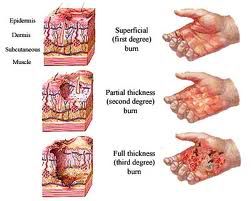Injuries that result from direct contact with or exposure to any thermal, chemical, or radiation source are termed burns. Burn injuries occur when energy from a heat source is transferred to the tissues of the body. The depth of injury is related to the temperature and the duration of exposure or contact.
Thermal Burns - exposure to or contact with flame, hot liquids, semi-liquids (e.g., steam), semi-solids (e.g., tar), or hot objects. Specific examples of thermal burns are those sustained in residential fires, explosive, automobile accidents, scald injuries, clothing ignition, and ignition of poorly stored flammable liquids.
Chemical Burns - caused by tissue contact with strong acids, alkalis, or organic compounds. The concentration, volume, and type of chemical, as well as the duration of contact, determine the severity of a chemical injury. Chemical burns can result from contact with certain household cleaning agents and various chemicals used in industry, agriculture, and the military.
Electrical Burns - caused by the heat that is generated by the electrical energy as it passes through the body. Electrical injuries can result from contact with exposed or faulty electrical wiring or high-voltage power lines. People struck by lightning also sustain electrical injury. Contact with current of greater than 40 volts is potentially dangerous; however, current of greater than 1000 volts is considered to be high-voltage current and is associated with extensive tissue damage.
Radiation Burns - the least common type of burn injury and are caused by exposure to a radioactive source. This type of injuries have been associated with nuclear radiation accidents, the use of ionizing radiation in industry, and therapeutic irradiation. Sunburn, from prolonged exposure to ultraviolet rays (solar radiation), is also considered to be a type of radiation burn.
Degree of Injury
Depending on the skin layers damaged, burn wounds are termed either partial-thickness burns or full-thickness burns. Burn wounds are also classified as first-, second-, third-, or fourth-degree burns. Partial-thickness burns involve injury to the epidermis and portions of the dermis.
- First-degree partial-thickness burns - are superficial and painful and appear red. They heal on their own by epidermal cell regeneration within about 3 to 7 days. Sunburn is a good example of a first-degree partial-thickness burn.
- Second-degree partial-thickness burns - appear wet or blistered and are extremely painful but can heal on their own (that is, without skin grafting) if they are small and do not become infected.
- Third-degree full-thickness burns - are characterized by damage throughout the dermis. A full-thickness burn appear dry and may be black, brown, white, or ivory. The denatured skin is called eschar (pronounced as "es-car"). The burned tissue is painless as a result of damage to the nerve endings; however, the surrounding skin is painful. Unless the area is very small (the size of a half-dollar), the full-thickness burn must be skin-grafted to heal.
- Fourth-degree full-thickness burns - involves skin, fat, muscle, and sometimes bone. The skin appears charred or maybe completely burned away. Areas of a fourth-degree burn require extensive surgical debridement and grafting. Amputation are common in these deep injuries. In addition to altered physical appearance, loss of skin leads to other problems.







0 comments:
Post a Comment